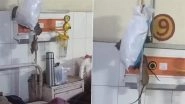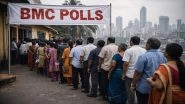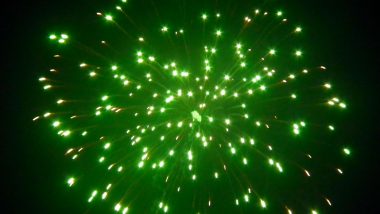Chennai, Aug 28: More than the uncertainty over Diwali celebrations due to Covid-19, the sword that is hanging over the country's firecrackers manufacturing hub Sivakasi is the production of 'Green Crackers', said manufacturers.
The Supreme Court has ordered a probe by the Central Bureau of Investigation (CBI) into the use of barium nitrate in the manufacture of firecrackers in contravention of its order.
The apex court had banned the use of barium nitrate as an ingredient in the manufacture of firecrackers.
Industry players had told IANS that the uncertainty over Diwali celebrations due to the Covid-19 pandemic has led to about a 30 per cent reduction in the production of firecrackers.
Diwali, the Hindu festival of lights, will be celebrated in November across the country and overseas.
"There are many festivals in India for which people buy new clothes, do special puja, make sweets at home and greet friends. Diwali is the only national festival where firecrackers are used," Tamil Nadu Fireworks and Amorces Manufacturers Association (TANFAMA) President Ganesan Panjurajan told IANS.
According to him, many firecracker units are making 'Green Crackers' with the formulations provided by the Council of Scientific and Industrial Research (CSIR) and the National Environmental Engineering Research Institute (NEERI).
Panjurajan said the apex court had tasked the CSIR and NEERI to come out with firecracker formulations that are less polluting.
"The CSIR and NEERI has given the industry the formulations that cut down the pollution levels by 30 per cent as compared to earlier levels. The industry is making the products as per the formulations given by them," Panjurajan said.
The formulations developed by CSRI and NEERI contain barium nitrate. Industry officials told IANS that without barium nitrate, 60 per cent of the firecrackers can't be made.
Citing Rule 13 of the Environment (Protection) Rules, 1986, an industry official said that a product cannot be banned when there is no substitute and even if there is any, a gestation period for transfer of technology should be given.
Industry officials also told IANS that the firecracker industry has been attacked in a concerted manner for a long time -- first it was on the grounds of employment of child labour, later on the issue of noise pollution and now air pollution.
"The air pollution in the National Capital Region (NCR) is high because of factors like the existence of thermal power plants, emissions from automobiles, stubble burning by the farmers in Punjab and the presence of several other industries. The pollution per se by the firecrackers is very negligible and it will go in a day's time," Panjurajan said.
According to the industry officials, the sectoral regulator -- the Petroleum and Explosive Safety Organisation (PESO) -- does not agree with the production of firecrackers with barium nitrate citing the apex court's order.
"The industry should have obtained a clarification from the apex court on the use of barium nitrate in the formulations developed by CSIR and NEERI, but it didn't do. As per our understanding of the apex court order, the industry can make firecrackers with the formulations given by CSIR and NEERI," Panjurajan said.
He added that the industry had obtained legal opinion to this effect.
"The proper scientific way of bringing down the emissions is to fix the maximum levels. The industry will then come out with their products. Without fixing the base level emissions and saying that the use of new formulations would reduce the emissions by 30 per cent is not scientific," Rajendra Raja, Vice President, Indian Fireworks Manufacturers' Association, told IANS.
It is learnt that one of the ways discussed to reduce the emission levels is to cut down the ingredients, which was not a customer friendly move.
"The government or the Supreme Court should lay down the emission norms. That will be a transparent and open process. Incidentally, there are no emission norms for the firecrackers elsewhere in the world," a firecracker manufacturer in Sivakasi not wanting to be quoted told IANS.
Sivakasi in Virudhunagar district in Tamil Nadu accounts for nearly 90 per cent of the country's firecracker production, and has 1,070 firecracker units located in and around it.
About 300,000 workers are directly employed by the firecracker industry and another 500,000 workers are in the allied sectors.
The production value of firecracker factories in Sivakasi is about Rs 2,500 crore and the retail sales value may be about Rs 6,000 crore. So, the current year production value may be just about Rs 1,800 crore.
For a long time, the fireworks industry has been a target in different forms.
First, the manufacturers were targeted for child labour and it was followed up with the noise pollution charge. With the noise pollution issue getting resolved with the laying down of the norms, the industry is being charged with polluting the air. "The next charge may that the brightness emitted by the firecrackers are injurious to the human eyes," commented an industry player.
The industry players and common people are of the view that Hindu festival Diwali is being targeted by vested interests.
Manufacturers say that Sivakasi would have turned into a ghost city long back if firecrackers were the reason for air pollution in Delhi.
On an average, the industry players daily burst around Rs 1,00,000 worth of crackers for testing purposes, but people breathe good air and there are different kinds of birds in Sivakasi, industry officials said.
"The automobile industry was given a long buffer time to shift over to the BS VI emission norms. But the fireworks industry was not given any norms or time to change over," a manufacturer said.
(The above story first appeared on LatestLY on Aug 28, 2020 04:20 PM IST. For more news and updates on politics, world, sports, entertainment and lifestyle, log on to our website latestly.com).













 Quickly
Quickly


